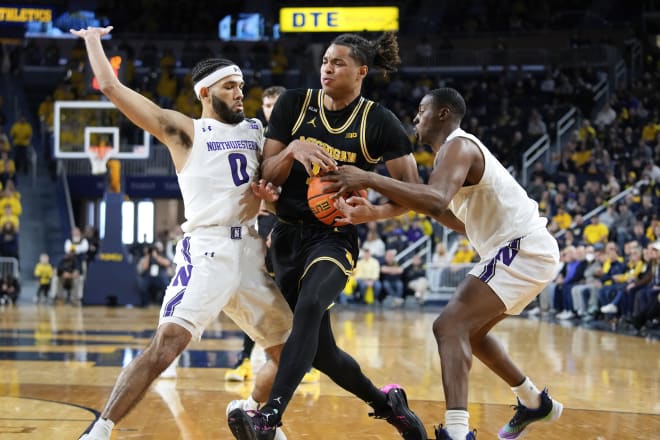Three-pointers are the chink in Northwestern's defensive armor

Northwestern’s 12-5 start this year has been built on its defense.
Despite allowing more than 80 points in two of their last three games, the Wildcats are still No. 2 in the Big Ten in scoring defense, and KenPom.com ranks them 15th in the nation in defensive efficiency. That’s impressive.
But there is a chink in the Wildcats’ defensive armor. Actually, it is more like a gaping hole: defending the three-pointer. And it’s something they have to fix before this current two-game losing streak turns into a longer one that derails their season.
On Saturday, Michigan shot a blistering 45.5% from beyond the arc to beat Northwestern, 85-78. It was the Wolverines’ second-best three-point shooting performance of the season. They hit 10 triples in 22 attempts and outscored the Wildcats 30-18 from long distance, despite the fact that NU took one more shot than they did.
More tellingly, it was the fifth time in the last six games that Northwestern’s opponent shot better than 40% on three-pointers. Only Illinois, which shot a dismal 28.6%, wasn’t able to reach the 40% mark. Even Indiana, which Northwestern beat, 84-83, in Bloomington on Jan. 8, shot a red-hot 50% on its three-pointers.
As a result, Northwestern has a strange dichotomy in its defensive statistics: the Wildcats rank second in the conference in scoring (60.8%) and field-goal percentage (38.6%) defense, yet they are dead-last, and 260th in the nation, in three-point percentage defense (34.8%).
Even with this three-point issue, Northwestern’s defense is still tenacious. The Wildcats rank second in the Big Ten in steals per game (8.7) and are No. 1 in turnover margin (+4.9). Chase Audige leads the league in steals, with 2.9 per game.
But if the other team doesn’t turn the ball over early in the shot clock and they are able to get into their half-court offense, Northwestern can be vulnerable to triples.
NU’s weakness was on full display against Michigan. Northwestern forced the Wolverines into 18 turnovers, the most they’ve committed all season. But the Wolverines were able to overcome their sloppiness by hitting threes.
Michigan used skip passes along the perimeter to find an open shooter beyond the arc, and Northwestern defenders consistently looked a step slow in reaching them. Jett Howard hit 4-of-6 threes, Dug McDaniel 3-of-7 and Kobe Bufkin 2-of-3. And the Wolverines were consistent, going 5-for-11 in each half.
Northwestern’s 65-62 loss to Rutgers last Wednesday was an even more glaring example. The Scarlet Knights, who have hit fewer threes than anyone in the Big Ten (5.9 per game), were able to go off against the Wildcats at Welsh-Ryan Arena.
The Knights made a season-high 11 triples against the Cats by shooting a scalding 61.1%, by far their best long-distance marksmanship of the season. They actually shot better on three-pointers than two-pointers (33.3%). Rutgers’ next-best long-range shooting night was when they hit 44.4% against Central Connecticut State in November.
Cam Spencer, the younger brother of former Wildcat guard Pat Spencer, played the role of the villain against Northwestern, draining 6 of 7 from beyond the arc, including what turned out to be the game-winner with 15 seconds left.
What exacerbates the problem for the Wildcats is that they are not good three-point shooters themselves. They rank 12th in the Big Ten in three-point shooting at 31.4%, despite attempting more triples than all but two other teams in the conference.
Northwestern is still a strong defensive team, and defense will continue to be its calling card. But if they want to be elite and take a run at an NCAA Tournament bid, they need to get better at guarding the perimeter.